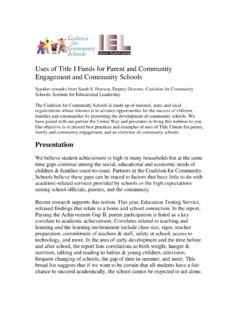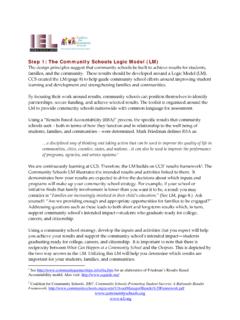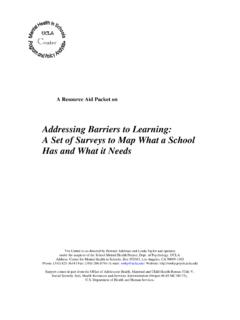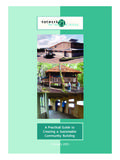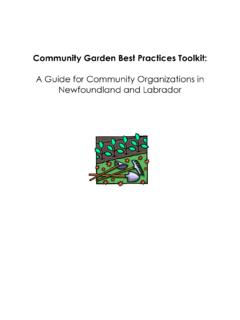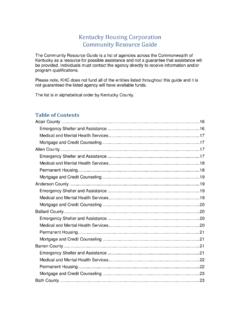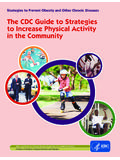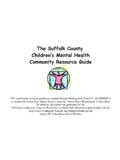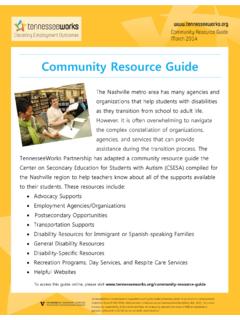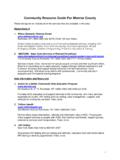Transcription of Community School Transformation: A Guide for …
1 The Federation for Community Schools Community School transformation : A Guide for Schools, Districts, Parents, and Community Members Working Together to Improve Outcomes for Students, Families and Communities , PARTNERSHI PSBROADER OPPORTUNI TI ESHEALTHFAMILIESCOMMUNITYACADEMICSSu c c e s sf u lSt udent s, FamiliesSchools &Communit iesINTEGRATED LEARNINGLEVERAGEDRESOU RCESShar ed leader shipDat a driven decision makingCollaborat ionShared vision Community School transformation : A Guide for Schools, Districts, Parents, and Community Members Table of Contents: Section Page Number Community Schools: The Future Of Education 1 Components Of A Strong Foundation 5 Foundation: Shared Vision 6 Foundation: Partnership 7 Foundation: Shared Leadership, Decision Making & The Advisory Board 9 Foundation: Broader Opportunities 12 Foundation: Leveraged Resources 13 Foundation: Collaboration 14 Foundation: Using Data: Needs And Resource Assessments 16 Foundation: Integrated Learning 20 Pillars: The Four Pillars Of Support For Student Development 22 Pillars: Parents as Community School Partners 24 Human Capital: Resource Coordination And Program Management 27 Realizing The Vision: Logic Models & Planning For Sustainability 30 Preparing For Implementation 32 Other Implementation Issues 34 Principles Of Community Schools 37 - 1 - Community SCHOOLS: THE FUTURE OF EDUCATION Most schools and communities in the United States and beyond face a common challenge: families, Community members and educators want the best education available to children and look for ways to meet children s non-academic needs.
2 Schools and students also benefit from involved families and Community members, two proven avenues for improving student achievement. The Community School framework provides an effective and proven structure through which schools improve academic outcomes, meet the developmental needs of all children and become a true resource for families and Community members. What IS a Community School ? A Community School is a partnership among Community stakeholders, parents and schools focused on supporting student development, improving student outcomes, supporting families and developing strong communities. When schools, families and communities work together, every component of this partnership can be strengthened and engaged. In addition, Community schools organize resources around the holistic development of young people in a student-centered environment ( , the School ). Community resources are more effectively and more efficiently used because schools and service providers can coordinate their interventions to deliver stronger outcomes and improve accountability for public and private funds.
3 Students and families are more successful and the whole Community benefits from partnerships that support the development of all. Afterschool academic timeGiven how practical and powerful the Community School model is, many schools have already begun the journey toward becoming Community schools. The first step is to recognize that schools cannot do everything that they are being asked to do alone. They need to forge partnerships with communities in order to do it all. Students come to School with a range of capacities and challenges. Strong schools recognize the importance of partnering with other organizations to ensure that all students developmental needs are met. By building strong partnerships among schools and service providers, Community schools deliver a more integrated approach to student and family development. In addition to forging partnerships to meet non-academic needs, Community schools also actively support academic development by coordinating and aligning programs and outcomes with classroom learning, and therefore support student success.
4 - 2 - Most simply put, Community schools work because they follow the ABCs. Community School A definition A Community School is both a place and a set of partnerships between the School and Community resources. Working collaboratively, schools, families and Community partners organize resources according to the interests and needs of local students and their families. Programs and services are delivered at and around the School before, during, and after the traditional School day and align outcomes with the academic curriculum and all areas of student development. Source: The Coalition for Community Schools Community schools are like many other high-quality schools. Beyond a focus on core academic instruction, high-quality schools ensure that barriers to academic success are identified and removed. A Community School creates partnerships to do just those things to strengthen academic performance and eliminate barriers to learning.
5 Community School programs are coordinated along four pillars of support: 1. Academic Development A Community School offers programs and services to ensure that academic remediation, academic support and academic enrichment are offered in addition to a strong core instructional program taught by high quality motivated teachers. Academic, cultural and arts-related programs are aligned to classroom learning, and enhance--rather than duplicate--children s classroom experiences. 2. Healthy Minds & Bodies A Community School ensures that physical, mental and social emotional developmental needs are addressed through curriculum, services and programs. Mental and physical health-related barriers to learning are removed. Students and families have information and tools to achieve optimal health. 3. Family Support & Engagement A Community School recognizes parents as important resources, and pays attention to creating a positive, welcoming and supportive School climate and to providing a range of opportunities for parental involvement.
6 A Community School provides programs and services that support parents capacity to be advocates for their children s success. This sometime means offering programs and services directed toward parents needs. It can also mean recognizing that parents often have the capacity to bring skills and resources to the Community School partnership. 4. Community Engagement A Community School is actively engaged with the Community and provides services, programs and supports for Community members. It serves as a resource for Community learning and partners with the Community provide resources that support student and family development. ABC s of Community Schools: A = Align out of School time with class learning B = Bring communities, families and schools together + C = Coordinate resources for children and families Success for children, families, schools and communities - 3 - Underpinning the programmatic pillars are guiding principles, common to Community schools.
7 Community schools: - Foster strong partnerships - Share accountability for results - Set high expectations for all - Build on the Community s strengths - Embrace diversity - Avoid cookie-cutter approaches - Follow the ABCs (align, bring together and coordinate) - Plan for sustainability Local leaders use these principles as benchmarks against which to measure the readiness of the schools in their communities, determine if schools already function as Community schools, and evaluate/identify opportunities for further development. Some key questions to assist with this examination include: - How successful are the School and School Community at ensuring students are achieving developmental milestones? - Are other human development and support systems in the Community effective in addressing student and family developmental needs? - How well do the systems that are in place coordinate and align their resources and services to ensure maximum effectiveness and efficiency?
8 - Do families and residents have easy access to all programs and services that are designed to enrich and support their development? Community School leaders, practitioners and supporters have identified the Parthenon as a symbol of stength and longevity and a model through which to articulate Community School components. The Parthenon provides a visual depiction of how all of these pieces fit together and work in concert to yield strong outcomes for students, families and Community members. PA RTN ERSH I PSBROADER OPPORTUNI TI ESHEALTHFAMILIESCOMMUNITYACADEMICSSu c c e s sf u lStudents, FamiliesSchools &Communit iesINTEGRATED LEARNINGLEVERAGEDRESOU RCESS hared leadershipDat a dr i ven decision makingCollaborat ionShared vision - 4 - It is helpful to keep a few things in mind as this development begins. First, there is no one right way for a Community School to look Community schools look however they need to look to meet their unique student, family and Community member needs.
9 Similarly, there is no one right way to create a Community School , but there are some guidelines, frameworks and processes that contribute to a more efficient developmental process. These guidelines and frameworks take into account best practices and lessons learned from schools in Illinois and across the country who have undertaken this transformation . Moving into Community School Development When a group of people comes together to begin the process of developing into a Community School , it is imperative that the group consider if all voices are at the table. The team ideally comprises representatives from all of the different groups that will be instrumental in and will benefit from Community School development. This includes School leadership, staff members, Community representatives, parents and even students. Together this team explores the idea of developing a Community School , starting with assessing the current level of Community School development.
10 Many schools and partnerships operate as Community schools on some level, without attributing their work to the Community School model. By assessing the current level of Community School development, teams can identify work on which to build. This team also can comprise the advisory board, as the development moves further along. - 5 - COMPONENTS OF A STRONG FOUNDATION Many teams, as they begin this work, discover that some of what s needed to facilitate Community School development is already in place at the School or in the Community . This Guide is designed both to support teams who are starting from scratch, and to enable teams that have identified some work already underway to build upon these foundations (see the Parthenon diagram in the previous section). Teams are advised to remember that: - No two Community schools are identical each is created based on the needs and available resources in School / Community .



